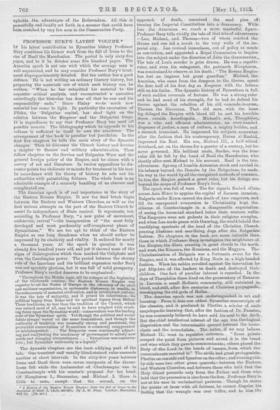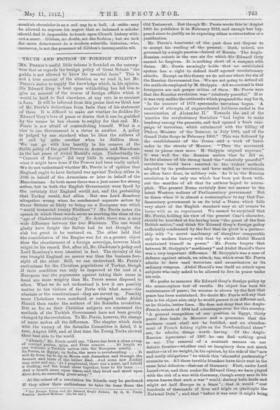PROFESSOR BURY'S LATEST VOLUME.*
IN his latest contribution to Byzantine history Professor Bury continues his former work from the fall of Irene to the rise of Basil the Macedonian. The period is only sixty-five years, and to it he devotes some five hundred pages. The Amorian epoch is not one with which the average man is well acquainted, and he may consider Professor Bury's treat- ment disproportionately detailed. But the author has a good defence. He is 'not writing an ordinary literary history, but preparing the materials out of which such history can be written. " When he has submitted his material to the requisite critical analysis, and reconstructed a narrative nocordingly, the historian has done all that he can and his responsibility ends." Since Finlay wrote much new material has come to light. In particular the excavation of Pliska, the' ' Bulgarian capital, has shed light on the relation between the Emperor and the Bulgarian kings. It is superfluous to say that Professor Bury has used all possible sources. The bibliography which he appends to his voleme is sufficient iu itself to awe the smatterer. The arrangement of the book is peculiar but justifiable. In the first five chapters he tells the main story of the dynastic changes. Then he discusses the Church history and devotes a chapter to finance and military administration. Then follow chapters on the Servian and Bulgarian Wars and the general. foreign policy of the Empire, and he closes with a survey' of art and literature. In twelve appendices lie dis- cusses points too elaborate or minute for treatment in his text. In accordance with his theory of history he seta out his authorities with painstaking fullness. The whole book is an admirable example of a masterly handling of an obscure and complicated' era.
The Amorian epoch is of real importance in the story of the Eastern Roman Empire. It saw the final break begin between the Eastern and Western Churches, as well as the first serious attempts on the part of the Eastern Church to assert its independence of State control. It represents, too, according to Professor Bury, "a new pulse of movement, endeavour, revival "—the inauguration of "the most fully developed and most pardonably self-complacent phase of Byzautinism." We are too apt to think of the Eastern Empire as one long decadence when we should rather be impressed by its elasticity and vitality. It endured for nearly a thousand years. At the epoch in question it was already five hundred years old, and yet it showed none of the signs of disintegration which then marked the Caliphate and even the Carolingian power. The period between the stormy rule of the Isamia.ns and the brilliant expansion under Basil was not specially glorious, but it was full of solid prosperity. Professor Bury's verdict deserves to be emphasized : "Throughout the Middle Ages, till its collapse at the beginning of the thirteenth century, the Eastern Roman Empire was superior to all the States of Europe in the efficiency of its civil and military organization, in systematic diplomacy, in wealth, in the refinements of material civilization, and in intellectual culture. It was the heir of antiquity, and it prized its inheritance—its politicallegacy from Rome and its spiritual legacy from Hellas. These traditions, no less than the tradition of the Church, -which was valued most of all, may be said to have weighed with crush- ing force upon the Byzantine world ; conservatism was the leading note of the Byzantine spirit. Yet though the political and social fabric always rested on the same foundations, and though the authority of tradition was unusually strong and persistent, the proverbial conservatism of Byzantium is commonly exaggerated or misinterpreted.- . . . The Emperors were continually adjust- ing and readjusting the machinery of government to satisfy now needs and changing eircumitances. . . . Byzantium was conserva- tive ; but Byzantine uniformity is a legend."
The dynastic chapters are the least edifying part of the tale. One transient and usually blood-stained ruler succeeds another at short intervals. In the sixty-five years between Irene and Basil there were seven occupants of the throne. Irene fell while the Ambassador of Charlemagne was in Constantinople with his master's proposal for her hand. Of Nicephorus I., Stauracius, and Michael I, there is little to note, except that the second, on the
A History of the Eastern n0111471 Empire: from the fail of Irene to the Accession. Of•Bootl. (.4.D,• 802-847). By J, B. Bury. London: Macmillan and Co. 1,12s. net.]
approach of death, conceived the mad plan of i turning the Imperial Constitution into a democracy. With Leo the Armenian we reach a more masterful figure. Professor Bury tells vividly the tale of that trio of adventurers —Leo, Michael, and. Thomas—two of whom reached, the- throne and one led a revolt to the very walls of the
perial city. Leo revived iconoclasm, out of policy as much, as conviction, and appointed a Royal Commission to inquire into the subject under the direction of John the Grammarian,. The tale of Lee's murder is grim drama. He. was a capable ruler, and even his antagonist, the patriarch. Nicephorus, . was constrained to observe at his death : " The Roman Empire- has lost an impious but great guardian." Michael, the Amorian, who came from the dungeon to the throne, spent: the first half of his first day as Emperor with. the fetters• still. on. his limbs. The dynastic history of Byzantium is full of such sudden reversals of fortune. He was a strong ruler and he had need .of his strength, for he had to defend his throne against. the rebellion of his old comrade-in-arms,. Thomas the Slavonian. That old man. with the lame leg deluged the Empire with blood till he met his horrible- doom outside Arcadiopolis. Michael's sou, Theophilus, was a wise and efficient administrator,. an even-handed. dispenser of justice, a man of culture, a mighty builder, and a staunch iconoclast. He impressed his subjects somewhat after the fashion. that his contemporary, Hama al-Rashid,,. impressed the East. His son,. Michael III., a half-witted drunkard, sat on the throne for a quarter of a century, but he- never governed. His brilliant uncle, Bardas, was the true- ruler till he fell by the hand of. Basil the Macedonian, who- shortly after sent Michael to his account. Basil is the true adventurer. Sprung of hatinble Armenian stock and carried in his infancy beyond the Danube by the Bulgarians, lie made his way in the world by all the recognized methods of romance. In him the Empire gained a great ruler, but his doings arer- beyond the scope of Professor Bury's book.
The epoch was full of wars. The fire signals flashed of ten,' across Asia Minor to apprise the capital of Saracen invasion.. Bulgaria under Krum caused the death of two emperors, and till its uuexpeoted conversion to 'Christianity kept the citizens of. Constantinople. in a disagreeable expectation- of seeing the horse-tail standard below their western wails. The Emperors were not pedants in their religious scruples, and when Leo made peace with Oilman, the world beheld the- unedifying spectacle of the head of the Christian Church pouring libations and sacrificing dogs after the Bulgarian. fashion. No chapters in the book are more valuable than those in which Professor Bury, investigates the neighbours a the Empire, the Slays massing in great clouds to the north. and west, the Khazars, the Russians, and the Magyars. The. Christianization of Bulgaria was a fortunate event for the Empire, and it was effected by King Boris in a high-handed fashion. When his nobles -revolted against the innovation ho put fifty.two of the leaders to death and destroyed their children. One fact of peculiar interest is recorded. In the days of Theophilus there lived on the promontory of Ttenaron in Laconia a small Hellenic community, still untainted in blood, and.atill, after five centuries of Christian propaganda, worshipping the old gods of Hellas.
The - Amorian epoch was not undistinguished in art and learning. From it date our oldest Byzantine manuscripts of the classics, and it produced in Photius a scholar of such- enoyclopaedic learning that, after the fashion of Dr. Faustus., he was commonly believed to have sold his soul to the devil, But the chief intellectual interest of the age was theological disputation and the interminable quarrel between the icono- clasts and the iconodulists. The latter, if we may believe Michael II., went to repulsive extremes. " Some priests scraped the paint from pictures and mixed it in the bread. and wine which they gave to-communicants ; others placed the Body of the Lord in the hands of images, from which the communicants received it." The strife had great protagonists, Photius on one side and Ignatius on the other ; and running side by side were two- other great quarrels—between the Eastern and Western Churches, and .between those who held that the
Holy Ghost proceeds only from the Father and those who held that the procession is also from the Son. Professor Bury is not at his ease in ecclesiastical pastures. Though he states the points at issue with all fairness, he cannot disguise his feeling that the wrangle was over trifles, and to him tho
• monkish chronicler is as a red rag to a bull. A critic may be allowed to express his regret that so balanced a scholar .should find it impossible to touch upon Church history with- out a sneer. Gibbon,mo doubt, set the fashion ; but we look for more detachment in a modern scientific historian, who, moreover, is not the possessor of Gibbon's incomparable wit.











































 Previous page
Previous page